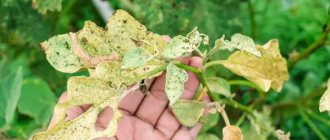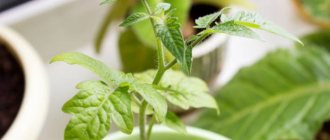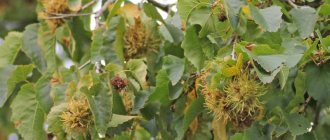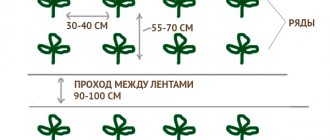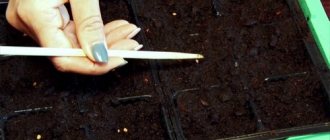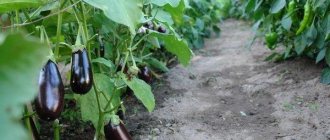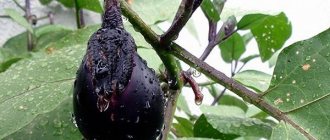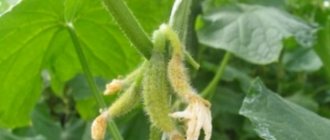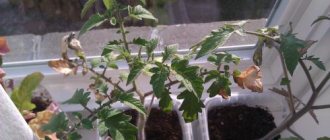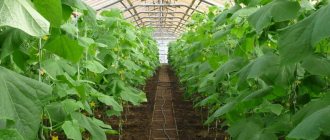Eggplants are quite popular among gardeners in our country, and if in the south of Russia it is allowed to grow this vegetable crop on ridges in open ground, then for the middle zone and northern regions it is necessary to use greenhouses and hotbeds. To grow a good harvest of eggplants, it is enough to comply with all the requirements imposed by the technology of growing vegetable crops in a greenhouse. However, many gardeners often face the problem of yellowing leaves or fruits and wonder why this phenomenon occurs and what to do in such a situation.
Why do seedlings turn yellow?
Yellowing of leaves is common when growing eggplant seedlings. This is due to the sensitivity of the culture to growing conditions. In this way, seedlings react to various violations of agricultural technology.
Reasons for yellowing of leaves of small seedlings and how to avoid them:
- Unsuitable soil. It is recommended to buy a ready-made balanced substrate. If you prepare the soil mixture yourself, it is important to observe its composition and proportions.
- Poor nutrition. Seedlings react quickly to both deficiency and overdose of fertilizers.
- Violation of the watering regime. There are no exact instructions regarding the frequency and norms of moisturizing. It is necessary to vigilantly monitor the condition of the soil, adjusting watering depending on the degree of drying.
- Diseases and pests. Seedlings easily pick up fungal and viral diseases and are attacked by insects if preventive measures are not taken to disinfect the soil, seeds, and spraying.
- Thickened plantings. Failure to maintain intervals between adjacent plants and rows leads to a lack of light, moisture and nutrition for individual specimens, which manifests itself in changes in foliage color.
- Lack of natural light. Sometimes the apartment does not have a south-facing window. Then the seedlings do not receive the required amount of sunlight for the process of photosynthesis, and the leaves acquire a pale yellowish tint. If there is a lack of lighting, you need to install phytolamps.
What to do about these problems?
To ensure that your efforts to grow this vegetable in a greenhouse are not in vain, you need to take action at the first signs of wilting. First of all, it is necessary to determine what exactly in this case caused the yellowing and wilting of the greenery.
- If this is not related to acclimatization after transplantation, then you should carefully check whether the entire range of agrotechnical measures is carried out for this crop?
Does the plant fully receive nutrients and microelements for development and growth? For eggplants, it is especially recommended to carry out foliar feeding with potassium and nitrogen. Additionally, you can feed with yeast or milk solution. - If there was excessive watering or cold water was used, the soil must be dried for several days. In order to avoid getting stone soil after drying, it is worth loosening the soil every day to ensure the necessary air exchange.
- If harmful insects are detected, then it is necessary to treat the plants very carefully and comprehensively. This is due to the fact that many pests from eggplants move into the soil and serve as a source of infection of other crops, because can remain viable for quite a long time.
Why do eggplants turn yellow indoors and outdoors?
Eggplants are able to react equally to completely different negative factors - from improper watering to pest attacks. To determine the cause of yellowing of the leaves, you need to carefully examine the plant and analyze all the nuances of agricultural technology.
Reaction to transplant
Transplantation is always a strong stress for eggplants, disrupting their usual rhythms and growth conditions. The main reason for yellowing leaves is damage to the roots. To prevent this from happening, the seedlings are moved from the glass to the ground along with a large lump of earth.
If everything is done correctly, within a week the plants will recover, take root, traces of stress will disappear, the leaves will become strong and green.
When transplanting eggplant seedlings to a permanent place, it is recommended to grow them in peat pots. In this case, the sprouts are planted together with the container, which can significantly reduce stress and avoid damage to the roots.
Wrong landing pattern
This problem is most acute in greenhouses, as gardeners strive to economically use the area of closed soil. In fact, such savings “backfire.”
In dense plantings, the lower leaves have no way to get their share of light. They stop photosynthesizing, turn yellow, and the plant discards them.
A similar phenomenon is observed in open ground, when mature eggplants begin to grow and the tops of adjacent rows close together. Finding themselves unnecessary, the lower leaves turn yellow and fall to the ground.
To avoid such a problem, you should initially follow the planting pattern. If “trouble” has already happened, you need to thin out the beds as soon as possible.
Distance between adjacent bushes:
- low-growing varieties - from 60 cm;
- tall - 80–100 cm.
Eggplant bushes are formed regularly, removing 1-2 leaves and side shoots every week.
Unsuitable soil
Heavy soils with high acidity often cause yellowing of eggplant leaves. The nightshade crop tolerates peat soils worst of all.
Eggplant needs loose, fertile soil with good aeration. To improve the structure, sand, perlite, vermiculite, and coconut substrate are added to it.
If the soil type meets the requirements of the vegetable, but the leaves still change color, then there is a low amount of nutrients in the soil. This happens when crop rotation is incorrect.
Eggplants should not be planted in areas where tomatoes or other plants of the nightshade family previously grew. Also, the crop is not planted after tobacco.
Root damage
It is possible to damage the roots of plants not only when transplanting seedlings, but also during subsequent care. Damage to the root system has an extremely negative effect on the condition of eggplants, as they do not receive enough moisture and nutrition.
To avoid such a problem, all work related to the soil - weeding, loosening, hilling - must be carried out extremely carefully. It is important not to touch the roots and stems of plants with the hoe.
Irrigation violation
At the seedling stage, eggplants are watered once a week; during flowering and fruiting, the frequency of watering is doubled. Eggplants are hydrated in the same way in hot weather.
Pour water only at the root of the plant until the soil is wet to the entire depth of the roots. Moisture should not get on the leaves and stems. For irrigation, settled water heated in the sun is used.
If the leaves turn yellow, it is likely that the reason is a violation of the watering rules:
- yellowness occurs both when watering norms are exceeded and when there is a lack of moisture;
- yellowed tops signal an excess of water; if the lower leaves turn yellow, the plants do not have enough moisture.
Water the eggplants only with warm water. If you use cold water, the roots of the plants will rot.
Temperature changes and sunburn
Eggplants are very sensitive to cold and do not respond well to sudden changes in temperature. Similar cases are common in central Russia. Daytime heat is often replaced by night coolness, which leads to a decrease in plant immunity and a change in leaf color.
Experienced gardeners refrain from planting crops in open ground. They provide vegetables with a separate greenhouse or hotbed.
In warm regions or during dry summers in the temperate climate zone of the country, another problem occurs. Direct sunlight will burn the tender leaves of eggplants. Spots and specks caused by the sun appear only on the front side of the leaf.
Shading during the peak solstice period—from noon to 4 p.m.—helps avoid burns.
Lack and excess of nutrition
If a plant does not receive enough nutrients, its leaves turn yellow and dry out. Based on the characteristics of changes in the color of leaf plates, they calculate which element the plant lacks.
What do eggplant leaves look like when there is a deficiency of macro and microelements:
- calcium - loss of color and dried ends;
- nitrogen - lightening of apical leaves;
- iron - the leaves themselves turn yellow, and the veins turn green;
- potassium - the edges of the leaves curl upward, turn brown, dry out and crumble;
- zinc - the lower leaves are covered with yellow-brown spots;
- boron - the apical leaves become pale yellow and curl;
- magnesium - leaves lighten and become covered with yellowish spots.
Fertilized soil before planting eggplants prevents plants from starving. If a problem is detected during the growing season, the crop is fed with the appropriate element.
An excess of minerals is no less harmful than their deficiency. A similar situation occurs when fertilizer is applied excessively or too frequently.
Features of growing eggplant (video)
Strict adherence to growing conditions will allow you to obtain a high-quality harvest and will significantly facilitate all stages of caring for vegetable crops cultivated in protected soil conditions.
In order not to lose the material, be sure to save it to your social network VKontakte, Odnoklassniki, Facebook by simply clicking on the button below.
This is a unique variety of eggplant with an atypical yellow color! It will be a true hit in the garden and even in the flower garden. Its fruits are small, round, with glossy skin, and the size of an egg. They are harvested when they are a bright golden hue.
In the homeland of this variety, Thailand, such eggplants are used in many traditional dishes and as a side dish.
Ripens in 60–70 days.
You can buy the seeds of this eggplant in the online store Chudogryadka.rf (https://chudogryadka.ru/product/baklazhan-zolotye-yajt..) - just follow the link to place your order.
Delivery within Russia by mail is free!
Delivery within Russia by mail is free!
Ekaterina LEONOVA
Traditional eggplants are dark purple. However, breeders managed to radically transform them. Now you can find white, green and even... red and yellow varieties on sale! What is this: a tribute to fashion? After all, it is known that lately summer residents have been loving to grow exotic plants. Or is there something about them that sets them apart from their purple brothers in the garden?
It turns out that it's not just about fashion.
White
These eggplants always taste better than the traditional blue ones.
First of all, they are never bitter. Yes, traditional eggplants also have varieties and hybrids without bitterness, but here you need to carefully read the annotation. But you can take white ones without looking - there is a 100% guarantee that they will have excellent taste.
Secondly, the taste of white ones is much richer and more intense. Almost all of them have a pronounced smell of champignons. And some resemble... chicken meat.
Varieties and hybrids in the online store chudrogryadka.rf:
Pelican F1, Ping Pong F1, Thai white ribbed.
Greens
White eggplants are tastier than purple ones, and green ones are tastier than white ones! This is noted by all summer residents who have grown them at least once. This is also confirmed by the chefs: they often prepare the most delicious dishes from green vegetables.
Variety in the online store chudrogryadka.rf:
Reds
When you see them, it’s hard to believe that these are eggplants - they look very much like tomatoes. They are usually not eaten as food; they are grown as ornamental. Their bushes are powerful, beautiful, completely strewn with bright fruits. This is the place to be in a flower garden!
Varieties in the online store chudrogryadka.rf: Red from Rotunda, Red Korean, Red Lulu, Orange from Cookstown.
Yellow
Another variety of decorative eggplants. Their fruits are usually small and round, the size and shape of chicken eggs, which is reflected in the names of the varieties. These are also worthy specimens for an exotic flower bed.
Variety in the online store
From the middle of summer, eggplants appear on the shelves, the beneficial properties of which can be discussed endlessly. Unfortunately, few lovers of blue ones (as eggplants are affectionately called in the south of Russia and Ukraine) know whether it is possible to get poisoned by eggplants, which sometimes leads to disastrous consequences.
Eggplant
And those who know the answer to the question are often too zealous with precautions, turning a healthy berry into a tasty, but useless brew. So what is the secret of eggplants and how to properly avoid poisoning with them?
The ovaries turn yellow
During the formation of ovaries, it is important to provide the eggplants with the most favorable conditions. Even minor non-compliance with agrotechnical requirements leads to the fall of the ovaries. To prevent a phenomenon leading to loss of yield, its causes must be eliminated.
Why do eggplant bushes shed their ovaries:
- lack of moisture;
- sudden temperature change;
- too bright sun in combination with dry winds (hot winds);
- deficiency of nitrogen and microelements in the soil.
Shading, wind protection, and drip irrigation will help prevent negative phenomena.
Prevention measures
The easiest way to prevent the problem is to provide the necessary conditions of detention. When purchasing seeds, it is important to choose healthy planting material that is not infected with fungus.
One of the important rules for caring for eggplants is to ensure sufficient watering and create a suitable temperature regime. To ensure adequate air flow, be sure to regularly ventilate the room and loosen the soil.
There are a number of other important rules in caring for eggplants from the moment they are planted in the soil:
- Consider the time of planting seedlings when planting them in a greenhouse. To prevent the young plant from experiencing severe stress, it is important to wait until the temperature in the greenhouse drops below 18 degrees. The same applies to maximum temperature indicators. They should not exceed 26-28 degrees. If the thermometer shows higher numbers, then this is the reason.
- Strictly follow all the rules for planting seedlings (disinfection of seeds, selection of suitable soil, creation of high-quality lighting);
- Apply special preparations or natural remedies to protect against fungus;
- Carry out full fertilizing in accordance with the fertilizer schedule;
- Loosen the soil regularly. This will increase the moisture and breathability of the soil.
When the slightest signs of disease appear, it is imperative to find out the cause and eliminate it. It is often necessary to completely remove diseased specimens from the greenhouse in order to protect other healthy ones. If the disease is detected in a timely manner, the likelihood of saving the plant and preserving the harvest is much higher.
The fruits are turning yellow
In the first stages of the growing season, only the eggplant leaves turn yellow. Subsequently, the fruits sometimes undergo a color change.
Causes:
- nitrogen deficiency;
- lack of moisture;
- diseases.
It happens that the plant looks completely healthy, the leaves are not disfigured by spots, and all the necessary preventive measures have been taken, and the fruits are yellowish. Perhaps a variety with yellow fruits has been planted - there are many of these among Asian eggplants.
Fruits may become mummified due to internal necrosis. Adult bushes affected by the disease cannot be treated. The disease is prevented by treating the seeds with hydrochloric acid before planting (planting material is immersed in a 10% solution for half an hour).
The sensitive crop reacts very quickly to the discomfort of growth, disease and pests, changing the color of the leaves, ovaries and fruits to yellow. This allows you to timely identify the cause and take action to eliminate the problem.
0
0
Copy link
What to treat and how to treat
The lower leaves of eggplants react by changing color to unfavorable factors. The acquisition of a yellowish or brown color, curling of the plates and wilting occurs when there is an excessive amount of salts in the soil. It is necessary to add special agents that neutralize salts. Too much heat from the lamps can also cause this defect.
Bacterial diseases. Often yellowing of the lower leaves indicates the initial stage of verticillium. As this disease develops, it spreads to other parts of the plant, leading to its death.
The disease is bacterial in nature and can be treated with specialized medications. The most effective are Vitaros, Previkur, Fundazol, Topsin-M.
For prevention, it is necessary to increase plant immunity. This includes providing them with fertilizing, promptly removing weeds, fighting pests, and eliminating the effects of contrasting temperatures.
I recommend watching the video (be sure to watch it to the end), you will learn a lot of new things:
Lack of nitrogen is one of the main reasons. Even with full compliance with the temperature and lighting conditions during the period of intensive growth, the soil is depleted and requires replenishment of the supply of nutrients.
When fertilizing with nitrogenous fertilizers, it is important not to exceed the dosage, otherwise the seedlings will become too brittle. The first sign of nitrogen overdose is curled leaves.
Fungal infection. Often, discoloration and wilting are caused by the presence of one of the types of fungus. Most often, this means that the seeds were infected already at the planting stage. In this case, specialized chemicals designed to combat fungal organisms are effective (Vitaros, Glyokladin - they kill pathogens of fungal infections in the soil).
To prevent the appearance of fungus and its development, it is necessary to ventilate the greenhouse and prevent overheating of the soil and eggplants.
General recommendations
Before the start of a new agricultural season, the area where the eggplants were grown (or a greenhouse or greenhouse) should be treated with antiviral drugs and a 0.5% trisodium phosphate solution and crop rotation should be observed.
To treat seeds, you can use fungicides Maxim or Lamador. These drugs not only fight viruses and bacteria, but also increase the immunity of future plants. Preventing infection is always more effective than fighting a disease; this rule also applies to plants, saving money, nerves, and time.
The most effective scheme for preventing diseases of eggplants and their yellowing is:
- choose eggplant hybrids that are resistant to viral diseases;
- carry out pre-sowing seed treatment;
- disinfect the soil before planting crops susceptible to the disease;
- treat the garden with insecticides and acaricides that act on sucking insects (disease carriers);
- treat with preventive fungicides;
- observe the watering regime, monitor the humidity and temperature of the air and soil;
- correctly observe crop rotation on the site and plan the proximity of plant species on it.
General characteristics
Long purple eggplant is classified as an early variety. The growing season lasts only 90 days from the moment the first shoots appear.
According to the description, the bush is low, about 70 cm. The stem is powerful and dense. The leaves are rich green in color, with a matte, rough surface. Productivity is high. About 2 kg of products are collected from the bush.
The fruits of the Long Purple eggplant are about 25 cm long, 5-7 cm in diameter, and weigh 300 g.
Use and taste
The pulp has a light, slightly greenish tint. Its structure is dense, not watery, so it is not necessary to soak it in salt before cooking to remove excess moisture. The taste is pleasant.
Used in preparing fresh dishes. Products of this variety are used for canned food and pickled culinary dishes.
